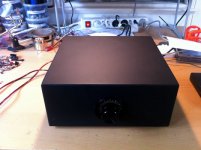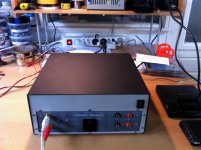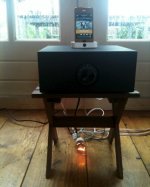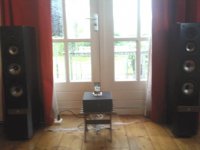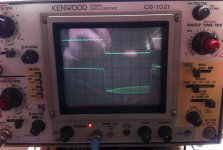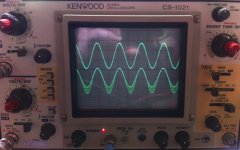Hi everyone. Just finished my first real  amp. A dual(ish) mono (a 300VA toroid for two mono 7294 amp boards and a 5V/12V transformer for leds and touch switches) with combined left/right volume buttons. Measurements with scope showed no issues and sound was awesome.
amp. A dual(ish) mono (a 300VA toroid for two mono 7294 amp boards and a 5V/12V transformer for leds and touch switches) with combined left/right volume buttons. Measurements with scope showed no issues and sound was awesome.
After a day of testing with my home system the sound started to annoy me. I checked the amp again and found the issue shown in the photo's. The sound was open and (too?) warm earlier. Now it has a kind of irritating grungy edge (everything sounds like Nirvana) . Can anybody explain what has happened?
. Can anybody explain what has happened?
Pictures show 1kHz square and 440Hz sine. Top line shows CD in; bottom line shows speaker out. The issue is with every frequency I throw at it...
Help!
After a day of testing with my home system the sound started to annoy me. I checked the amp again and found the issue shown in the photo's. The sound was open and (too?) warm earlier. Now it has a kind of irritating grungy edge (everything sounds like Nirvana)
Pictures show 1kHz square and 440Hz sine. Top line shows CD in; bottom line shows speaker out. The issue is with every frequency I throw at it...
Help!
Attachments
you have an instability of your amplifier. The TDA 7294 is a high frequency device and needs careful deployment to avoid oscillations.
Without scheme and print design it is hard to tell what causes this.
It can be that the 100nf decoupling capicitors are not close enough, or the grounding is not good, or the power cabling has high resistance. It can also be caused by the load you present to the amplifier.
The simplest solution might be to see if the zobel network (as in the datasheet) solves this for you.
Without scheme and print design it is hard to tell what causes this.
It can be that the 100nf decoupling capicitors are not close enough, or the grounding is not good, or the power cabling has high resistance. It can also be caused by the load you present to the amplifier.
The simplest solution might be to see if the zobel network (as in the datasheet) solves this for you.
Apart from Zobel ( very important ) check the compensation caps you have used. Remember that you can also get oscillations just by having some badly laid out tracks ! Double check EVERYTHING you have done including all ground traces. This kind of problem can sometimes take a long time solving. Best method is to relax a couple of days before looking at it again. When you do things too quickly you tend to 'always' miss the mistakes even by looking at it several times. A time gap often helps. 
I had a similar problem recently just by changing the external connections to the power amp. I used an electronic crossover at the input of the power amp. Problem was solved by changing the compensation on the power amp.
I had a similar problem recently just by changing the external connections to the power amp. I used an electronic crossover at the input of the power amp. Problem was solved by changing the compensation on the power amp.
Wow, love this forum. Thanx for the reply.
OK, just tested it with some different sets of loudspeakers (load: as suggested by chrswlr).
- nothing connected: perfect sine!
- 3.6 ohm connected: grunge (bottom half of sine filled with fuzz)
- 4 ohm connected: grunge (bottom half of sine filled with fuzz)
- 8 ohm connected: perfect sine!
Ashok. Very wise advice... "relax a couple of days". Especially for me, since I tend work through the night just to fix some annoyance.
Adam.
OK, just tested it with some different sets of loudspeakers (load: as suggested by chrswlr).
- nothing connected: perfect sine!
- 3.6 ohm connected: grunge (bottom half of sine filled with fuzz)
- 4 ohm connected: grunge (bottom half of sine filled with fuzz)
- 8 ohm connected: perfect sine!
Ashok. Very wise advice... "relax a couple of days". Especially for me, since I tend work through the night just to fix some annoyance.
Adam.
1) Use a 100nF rail-to-rail capacitor directly accross the chip's supply pins.
2) Put the Zobel (2R7 + 100nF) accross output and -Vs supply pin, again directly at the chip
3) Make sure the signal gain of the circuit is 20x (26dB) or higher and the feedback network is close to the chip and are low inductance. The GND leg of the feedback network must return to point where there is short distance to the local rail-to-GND decoupling capacitors.
Check frequency of the oscillation, if it is way above ~200kHz then it is local oscillation, 1) and 2) will help then. If it is ~200kHz then 3) is the culprit.
2) Put the Zobel (2R7 + 100nF) accross output and -Vs supply pin, again directly at the chip
3) Make sure the signal gain of the circuit is 20x (26dB) or higher and the feedback network is close to the chip and are low inductance. The GND leg of the feedback network must return to point where there is short distance to the local rail-to-GND decoupling capacitors.
Check frequency of the oscillation, if it is way above ~200kHz then it is local oscillation, 1) and 2) will help then. If it is ~200kHz then 3) is the culprit.
try to add LPF cap at the feedback resistor aside adding the boucherot cell..Any idea why the osc only shows at the sine bottom?
Google "bottom side fuzzies" With quotes around it. May help you find a solution. I'd try adding an inductor in parallel with a ~10 ohm resistor in series with the output as well as the boucherot cell. The inductor is a low pass filter and should be sized to pass the audio range and begin to roll off just above it. This should help to stabilize the amplifier. I'd do this before tinkering with the NF loop. I also like to see RF filtering on the input.
@johnr66
Well, your "inductor in parallel with a ~10 ohm resistor in series with the output" suggestion took care of the fuzzies alright! Thanx.
The amp's overload protection now comes in at much lower volume however...
And it keeps nagging me this looks more like masking the problem than solving it.
Adam.
Well, your "inductor in parallel with a ~10 ohm resistor in series with the output" suggestion took care of the fuzzies alright! Thanx.
The amp's overload protection now comes in at much lower volume however...
And it keeps nagging me this looks more like masking the problem than solving it.
Adam.
Yes, pins 15/8 and 13/7 (assuming that they are connected)KSTR,
Thanx for your suggestions. Still baffles me why earlier measurements didn't show anything wrong.
Will check 3) first since osc is indeed ~200kHz
1) Do you mean a 100nF cap across Vs-/pin 15 and Vs+/pin 13?
Any idea why the osc only shows at the sine bottom?
Adam.
The internal block schematic of the TDA7294 shows a local power buffer where the loop is closed around the low side power MOSFET. This is probably why the neg swing is more prone to oscillation when the MOSFET increases it gate-to-drain capacitance when voltage accross the MOSFET is low, decreasing overall stability.
Please post exact schematic and wiring (or PCB) diagram/photo for further help.
I have seen batches of TDA7294 that were more prone to oscillation than others. ST doesn't even specify a unity gain bandwith, let alone a full bode plot for the part.
From the fact your oscillation is at ~200kHz (that is about the intersect of the a gain of 20x and the estimated bode plot gain magnitude curve -- I also roughly measured that estimated bode plot), I would think your problem is one of global feedback and/or load isolation issues like you seem to have found out now. OTOH, the TDA7294 can easily handle capacitive load of about 1nF.
Last edited:
Yo all,
Problem solved.
Solution: zobel (2R7ohm + 100nF) across TDA7294 Out and V- and small inductor + 15ohm on negative speaker out. Sine wave is now as thin as a hair.
Thanx for all your input. I'm extremely impressed by the willingness to help out, and the knowledge available.
Regs to all.
Adam.
Problem solved.
Solution: zobel (2R7ohm + 100nF) across TDA7294 Out and V- and small inductor + 15ohm on negative speaker out. Sine wave is now as thin as a hair.
Thanx for all your input. I'm extremely impressed by the willingness to help out, and the knowledge available.
Regs to all.
Adam.
- Status
- This old topic is closed. If you want to reopen this topic, contact a moderator using the "Report Post" button.
- Home
- Amplifiers
- Chip Amps
- 7294 amp with 'grunge' issue
